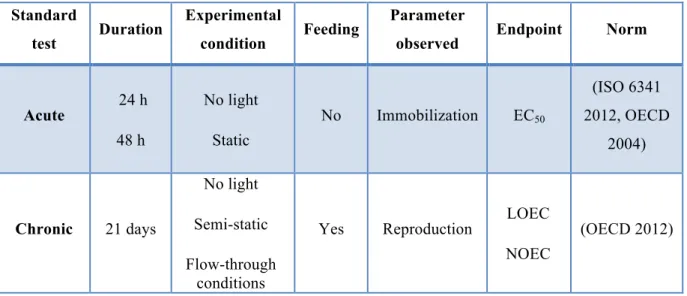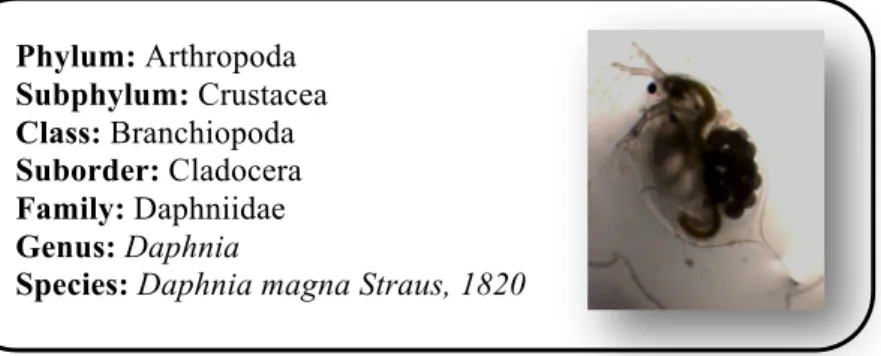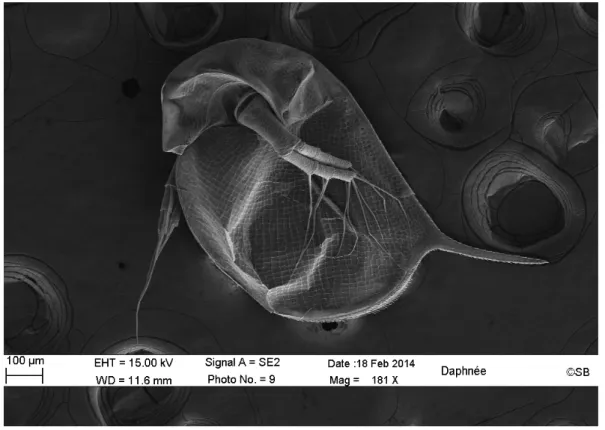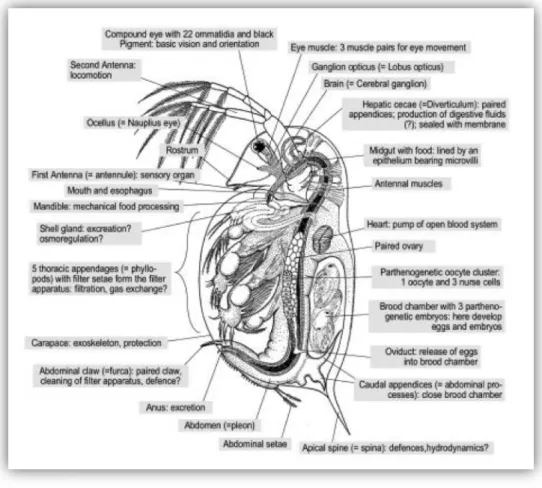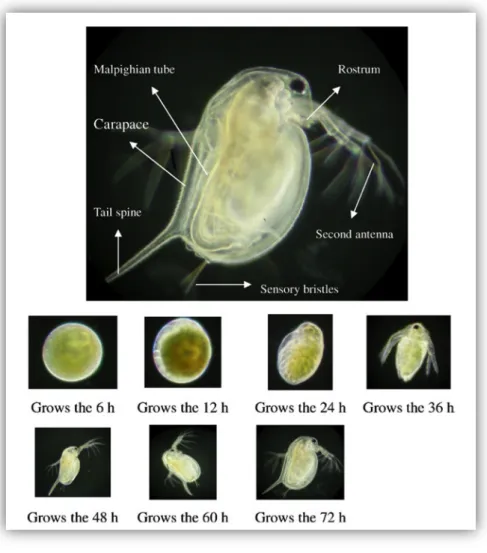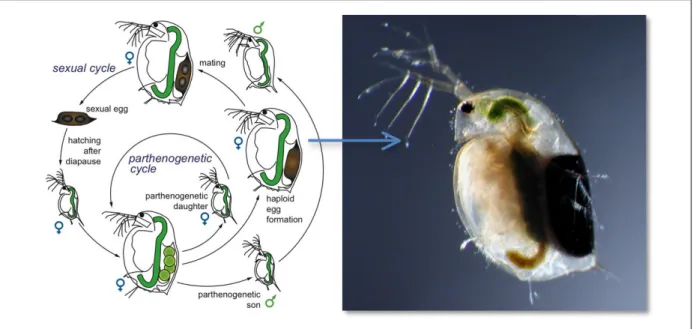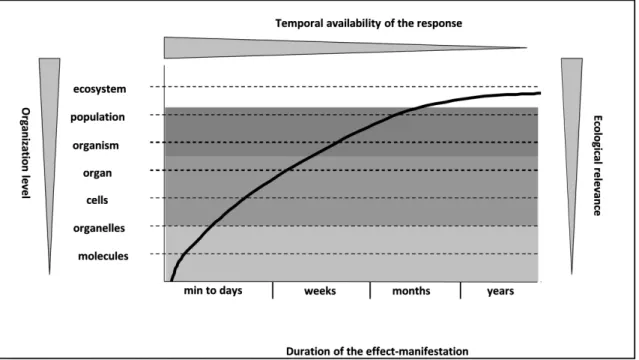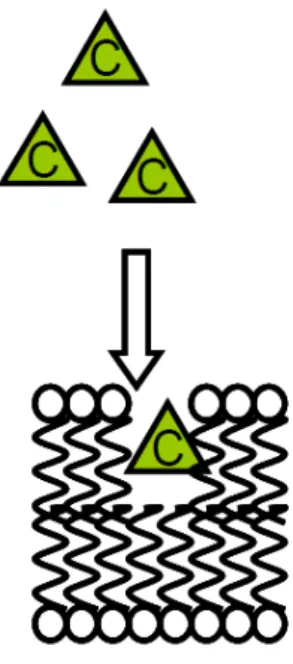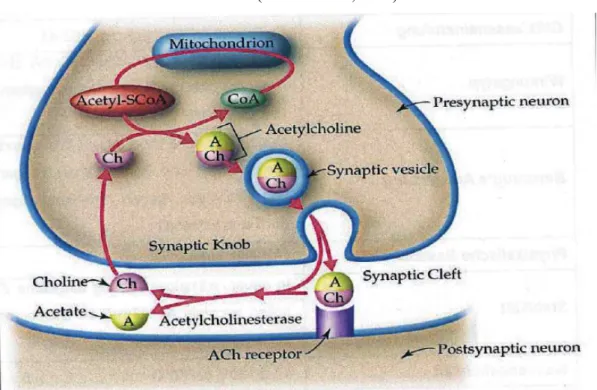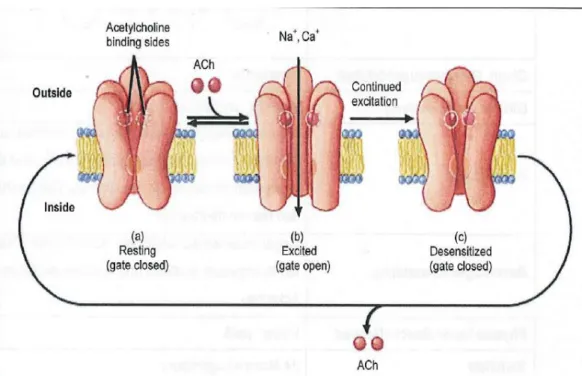HAL Id: tel-01160878
https://tel.archives-ouvertes.fr/tel-01160878
Submitted on 8 Jun 2015HAL is a multi-disciplinary open access archive for the deposit and dissemination of sci-entific research documents, whether they are pub-lished or not. The documents may come from teaching and research institutions in France or abroad, or from public or private research centers.
L’archive ouverte pluridisciplinaire HAL, est destinée au dépôt et à la diffusion de documents scientifiques de niveau recherche, publiés ou non, émanant des établissements d’enseignement et de recherche français ou étrangers, des laboratoires publics ou privés.
Utilisation du comportement natatoire de Daphnia
magna comme indicateur sensible et précoce de toxicité
pour l’évaluation de la qualité de l’eau
Julie Chevalier
To cite this version:
Julie Chevalier. Utilisation du comportement natatoire de Daphnia magna comme indicateur sensible et précoce de toxicité pour l’évaluation de la qualité de l’eau. Géochimie. Université de Bordeaux, 2014. Français. �NNT : 2014BORD0443�. �tel-01160878�
THÈSE EN CODIRECTION PRÉSENTÉE POUR OBTENIR LE GRADE DE
DOCTEUR DE
L’UNIVERSITÉ DE BORDEAUX
ÉCOLE DOCTORALE SCIENCES & ENVIRONNEMENTS LABORATOIRE NATIONAL HYDRAULIQUE ET ENVIRONNEMENTSPÉCIALITÉ: Géochimie et Écotoxicologie
Par Julie CHEVALIER
Utilisation du comportement natatoire de Daphnia magna comme
indicateur sensible et précoce de toxicité pour l’évaluation de la
qualité de l’eau
Sous la direction de
Jérôme CACHOT
, Matthias GROTE et de Pascal PANDARD
Soutenue le 30 octobre 2014 Membres du jury :
GEFFARD Olivier Docteur à IRSTEA de Lyon Rapporteur
SOUISSI Samy Professeur à l’Université de Lille1 Rapporteur
FORGET-LERAY Joëlle Professeur à L’Université du Havre Rapporteur
BEGOUT Marie-Laure Docteur à IFREMER, La Rochelle Examinateur
PANDARD Pascal Docteur Ingénieur à l’INERIS Co-encadrant (invité)
GROTE Matthias Docteur Ingénieur à EDF R&D Co-encadrant (invité)
Utilisation du comportement natatoire de Daphnia magna comme indicateur sensible et
précoce de toxicité pour l’évaluation de la qualité de l’eau
Résumé : Les paramètres comportementaux sont de plus en plus considérés comme étant des indicateurs sensibles et précoces de toxicité chez les organismes aquatiques. Cependant, l’utilisation du comportement natatoire comme critère de toxicité pour l’analyse de risque environnemental ou pour le contrôle de la qualité de l’eau reste pour l’heure encore limitée. En effet, il est actuellement difficile de quantifier la sensibilité des paramètres comportementaux et d’établir un lien entre les seuils d’effets comportementaux et les effets aigus et subaigus classiquement mesurés dans les tests en écotoxicologie. Dans le but d’améliorer notre compréhension des effets comportementaux des polluants sur Daphnia magna, nous avons développé un nouveau système de mesure du comportement multi-cuves baptisé « Multi-DaphTrack ». Douze substances toxiques, couvrant une large gamme de modes d’action différents ont été testées dans ce système. Un test standard d’immobilisation ainsi que des analyses de comportement dans le toximètre DaphToxI®, ont également été effectués pour chaque
substance afin de comparer les seuils d’effets comportementaux avec les paramètres classiques d’immobilisation. Les résultats des expositions aux différentes substances ont démontré que notre nouveau système d’exposition multi-cuves permet de détecter des effets comportementaux (i.e., augmentation de la vitesse de nage) significatifs et précoces pour l’ensemble des substances testées et ce, à des concentrations proches de la CE10 (48 h) du test aigu d’immobilisation dès la première heure
d’exposition. Des profils comportementaux différents ont été observés selon les substances testées (i.e., intensité, temps de latence et durée de l’effet) mais ceux-ci ne sont pas spécifiques d’un mode d’action particulier. Les résultats obtenus avec le toximètre DaphToxI® ont révélé des profils d’effet
similaires (i.e., augmentation de la vitesse de nage) bien que ce système soit globalement moins sensible par rapport au système « Multi-DaphTrack ». Pour conclure, notre nouveau système d’exposition multi-cuves « Multi-DaphTrack » est un outil plus sensible et précoce que le test standard d’immobilisation pour l’évaluation de la toxicité de substances chimiques. L’utilisation du système « Multi-DaphTrack » pourrait donc être envisagée, après quelques améliorations et validation supplémentaires, pour l’évaluation de la qualité des masses d’eau et des effluents.
Mots clés : Comportement natatoire, indicateur de toxicité, Daphnia magna, biosurveillance, polluants, mode d’action
Use of Daphnia magna swimming behavior as a sensitive and early indicator of toxicity
for water quality assessment
Abstract: Swimming behavior is increasingly reported as a sensitive and early indicator of toxicant stress in aquatic organisms. However, it remains unclear how to quantify the sensitivity of swimming behavioral endpoints and how to compare these effect thresholds with standard ecotoxicological endpoints used in risk assessment. To date, the systematic assessment of the sensitivity of swimming behavioral endpoints in daphnia is limited because of the restrained test capacity of existing behavioral analysis systems. Hence, we developed a new behavioral analysis multi-cell system named “Multi-DaphTrack” with a high throughput testing capacity in order to enhance our understanding of swimming behavioral effects in Daphnia magna under chemical exposure. Twelve compounds covering different modes of toxic action were selected and tested in this new system and in a single-cell commercialized biomonitor (DaphToxI®) and with the acute standard test. Our new multi-cell exposure system detected significant and early swimming behavioral effects (i.e., increase of the average speed) for most of the tested compounds and this, from the first hour of exposure at concentrations near the EC10 (48 h). Contrasted behavioral profiles were observed for average speed
(i.e., intensity, time of effect onset, effect duration), but no distinct behavioral profiles could be drawn from the chemical mode of action. Despite less sensitive, the DaphToxI® gave similar trends (i.e.,
rapid peak increase) compared to our “Multi-DaphTrack” system. To conclude, behavior analysis using our “Multi-DaphTrack” system could be used as an alternative or complement to the current acute standard test for toxicity assessment of chemicals. With some additional improvements and validations, it also could be used for quality assessment of water bodies and sewages.
Keywords: Swimming behavior, toxicity indicator, Daphnia magna, biomonitoring, pollutants, mode of action
Laboratoire National d’Hydraulique & Environnement
Utilisation du comportement natatoire de Daphnia magna comme indicateur sensible et
précoce de toxicité pour l’évaluation de la qualité de l’eau
RÉSUMÉ : Le développement exponentiel des activités industrielles, agricoles et urbaines
engendre le déversement croissant de nombreuses substances dans l’environnement. Le
compartiment aquatique est généralement le réceptacle final d’un bon nombre de ces
composés qui menacent le fonctionnement et la pérennité de l’écosystème. Cette pollution
diffuse, dû à la présence de contaminants de nature variée a entrainé une détérioration
progressive de la qualité des eaux européennes menaçant ainsi la biodiversité et l’équilibre de
l’écosystème aquatique. Une étude extensive recensant jusqu’à 4000 sites de biosurveillance
sur l’ensemble du continent Européen a récemment révélé que la moitié des eaux de surface
européennes était touchée par une pollution de contaminants organiques (Malaj et al., 2014).
Face à ces problèmes environnementaux, la Directive-Cadre Européenne sur l’Eau
(2000/60/CE) a été adoptée le 23 octobre 2000 par l’Union Européenne avec pour objectif
général l’atteinte du bon état écologique et chimique des eaux superficielles sur tout le
territoire des 28 pays de l’Union Européenne. Pour assurer la protection de la santé humaine
et de l’environnement, la réglementation REACh (Enregistrement, Evaluation et l’autorisation
des produits chimiques) est également entrée en vigueur le 1
erjuin 2007 (REACH 2006) et
impose aux industries la responsabilité d’évaluer les dangers et les risques liés à l’utilisation
des produits chimiques. Comme toute société industrielle, l’entreprise Energie De France
(EDF) est tenue au respect de la réglementation environnementale et se doit de conforter
l’acceptabilité environnementale de ses installations de production en surveillant l’absence
d’impact de ses activités vis-à-vis du milieu aquatique.
Actuellement, l’évaluation du risque environnemental liée à l’utilisation des
substances chimiques se résume le plus souvent à la réalisation de tests standards
monospécifiques de toxicité aigüe sur des organismes représentatifs de différents taxons et de
différents niveaux trophiques (e.g., algues, daphnies, poissons). En raison de sa simplicité, sa
rapidité et de son faible coût, le test de toxicité aiguë d’immobilisation sur Daphnia magna
(ISO 6341, 2012, OCDE 202, 2004) est l’un des tests les plus fréquemment utilisés parmi ces
outils standardisés pour évaluer la qualité de l’eau et la toxicité des effluents. L’espèce
Daphnia magna est sensible à une large gamme de polluants (Martins et al., 2007) et est
représentative des organismes d’eau douce (Baird & Van den Brink, 2007, Mark & Solbé,
et ce à seulement deux temps d’exposition prédéfinis (i.e., 24 heures pour l’évaluation des
effluents et 48 heures pour les substances chimiques). Ce test n’apparaît pas suffisamment
sensible pour évaluer des effets sublétaux pouvant être induits aux faibles concentrations de
contaminants généralement présents dans les eaux de surface. En effet, la contamination des
eaux de surface par des concentrations provoquant des effets de mortalité est rare voire
accidentelle. Comme l’indique l’étude extensive de 4000 sites de biosurveillance sur le
continent européen, seuls 6% des sites étudiés présentent des concentrations maximales
dépassant des seuils équivalents à 1/10 de la CE
50(48 h) chez la daphnie tandis que 38 % des
sites atteignent des seuils équivalents à 1/1000 de la CE
50(48 h) (Malaj et al., 2014).
Il apparaît donc nécessaire de développer des indicateurs précoces de perturbations
ainsi que des outils permettant de mieux comprendre la contamination chimique de l’eau en
termes d’impact pour mieux gérer le risque que représente cette contamination chimique tant
pour l’homme que pour l’environnement. Il y a donc une réelle nécessité d’améliorer ou de
développer des techniques permettant une détection précoce et une évaluation pertinente des
effets écotoxicologiques engendrés par des contaminants à des concentrations
environnementales. D’autres paramètres d’effets, autres que l’immobilisation, peuvent fournir
des indications sur les effets toxiques des polluants à des concentrations environnementales.
Par exemple, les paramètres comportementaux sont de plus en plus considérés comme étant
des indicateurs sensibles et précoces de toxicité chez les organismes aquatiques (Coelho et al.,
2011).
Les indicateurs comportementaux ont l’avantage de représenter des réponses rapides
et sensibles puisque le stress chimique peut induire des réponses rapides au niveau du
comportement natatoire chez les organismes exposés à des concentrations inférieures aux
seuils de toxicité aiguë (Amiard-Triquet & Amiard, 2013). De ce fait, les indicateurs
comportementaux sont bien adaptés pour la détection de concentrations environnementales et
pourraient contribuer à améliorer le processus d’évaluation des risques environnementaux
(Robinson, 2009). Cependant, l’utilisation du comportement comme critère de toxicité pour
l’analyse du risque environnemental ou pour le contrôle de la qualité de l’eau reste, pour
l’heure, encore limitée. En effet, il est actuellement difficile de quantifier la sensibilité des
paramètres comportementaux et d’établir un lien entre les seuils d’effets comportementaux et
les effets aigus et subaigus classiquement mesurés dans les tests en écotoxicologie. De plus, la
standardisation des différents profils d’effets comportementaux potentiellement observables
et la caractérisation des concentrations des substances chimiques engendrant ces effets n’est
pas simple. Pour une évaluation systématique de la sensibilité des paramètres
concentrations et réplicats pour permettre une comparaison avec les paramètres standards
d’immobilisation. Cependant, la capacité de test des systèmes de mesure du comportement
natatoire existants (notamment pour la daphnie) reste limitée et ne permet pas de tester
suffisamment de réplicats pour estimer la variabilité biologique du comportement et permettre
une comparaison avec le test standard. Actuellement, l’étendue des substances provoquant des
effets sur le comportement n’est pas connu, il est donc nécessaire d’explorer les différents
profils d’effets comportementaux induits par une large gamme de substances chimiques. En
principe, les substances qui possèdent un mode d’action similaire devraient engendrer des
effets toxiques similaires et donc des profils d’effets comportementaux similaires (Dom et al.,
2012, Zein et al., 2012).
C’est dans ce contexte général que se positionnent ces travaux de thèse avec comme
objectifs (i) le développement d’un nouveau système multi-cuves de mesure du
comportement sur l’espèce modèle Daphnia magna (ii) de comparer la sensibilité du test
comportemental par rapport au test standard d’immobilisation et (iii) d’analyser la
pertinence du comportement en tant que bioindicateur de toxicité pour l’évaluation de la
qualité des masses d’eau et des effluents. Dans le but d’améliorer notre compréhension des
effets comportementaux des polluants sur Daphnia magna, nous avons développé un nouveau
système d’analyse du comportement de la daphnie baptisé « Multi-DaphTrack » avec une
capacité d’analyses simultanées permettant le suivi de 20 groupes de daphnies exposés à
plusieurs concentrations et réplicats simultanément. Ensuite, pour explorer un large spectre
d’effets potentiels sur le comportement, douze substances toxiques, couvrant une large
gamme de modes d’action différents (i.e., narcotiques, modes d’action spécifiques et
multiples), ont été testées dans ce système. Un test standard d’immobilisation ainsi que des
analyses de comportement dans le toximètre DaphToxI
®, ont également été effectués pour
chaque substance afin de comparer les seuils d’effets comportementaux avec les paramètres
classiques d’immobilisation.
Après optimisation de conditions expérimentales stables dans le système «
Multi-DaphTrack », des analyses en condition témoin ont été réalisées pour mesurer la performance
du système. En raison de pertes de reconnaissance des daphnies et d’artéfacts, le taux initial
de détection n’atteignait que les 30% lors des premiers essais avec d’importantes variations
entre cuves, entre expérimentations et au cours des 48 h d’analyse. L’amélioration du
paramétrage de l’installation expérimentale et le réglage des paramètres du logiciel Zebralab
ont permis d’améliorer la détection avec un taux de 93%, homogène entre cuves et stable dans
critère d’évaluation le plus pertinent, i.e., la vitesse de nage puisque ce paramètre est plus
homogène et stable dans le temps comparé aux paramètres du nombre d’organismes actifs et
de la vitesse angulaire.
Les résultats obtenus ont montré que ce nouveau système « Multi-DaphTrack » permet
de détecter des effets comportementaux (i.e., augmentation de la vitesse de nage) significatifs
et précoces pour l’ensemble des substances testées et ce, à des concentrations proches de la
CE
10(48 h) du test aigu d’immobilisation dès la première heure d’exposition. Des profils de
réponse comportementale différents ont été observés selon les substances testées (i.e.,
intensité, temps de latence et durée de l’effet). Par exemple, l’exposition aux substances
narcotiques (i.e., isopropanol et éthanol) a induit une augmentation intense et rapide de la
vitesse de nage, suivie d’un retour progressif au niveau ou en dessous du niveau des contrôles.
A l’opposé, les effets sur la vitesse de nage des substances à modes d’action spécifiques ou
multiples sont plus hétérogènes et caractérisés par une forte ou légère augmentation de la
vitesse de nage suivie d’un retour rapide au niveau ou en dessous des contrôles. De plus, le
temps d’apparition des effets sur la vitesse de nage diffère entre les substances à modes
d’action spécifiques ou multiples avec une apparition rapide (e.g., fipronil, abamectin,
carbofuran, esfenvalerate, cyperméthrine et caféine), intermédiaire (e.g., imidacloprid, sulfate
de cuivre et la sertraline) ou retardée (e.g., trichlorfon). Ces profils comportementaux sont
contrastés entre les différentes substances testées mais ceux-ci ne sont pas spécifiques d’un
mode d’action particulier. Enfin, l’ensemble des résultats obtenus sur le «Multi-DaphTrack »
ont permis de montrer que les effets comportementaux débutent généralement au cours des 12
premières heures d’exposition (à l’exception du trichlorfon), et que les effets varient en
fonction du temps. Les résultats obtenus avec le toximètre DaphToxI
®ont révélé des profils
d’effet similaires (i.e., augmentation de la vitesse de nage) bien que ce système soit
globalement moins sensible par rapport au système « Multi-DaphTrack ».
Pour conclure, notre nouveau système d’exposition multi-cuves « Multi-DaphTrack »
est un outil plus sensible et précoce que le test standard d’immobilisation pour l’évaluation de
la toxicité de substances chimiques. L’utilisation du système « Multi-DaphTrack » pourrait
donc être envisagée, après quelques améliorations et validations supplémentaires, pour
l’évaluation prédictive de la toxicité des substances chimiques et l’évaluation de la qualité des
masses d’eau et des effluents.
REMERCIEMENTS
Ce travail a été réalisé au sein de l’équipe Evaluation des Risques Sanitaires et Environnementaux (ERSE) du Laboratoire National d’Hydraulique & Environnement (LNHE) sur le site EDF-Recherche et Développement de Chatou.
J’exprime ma profonde reconnaissance à Jérôme CACHOT, Professeur à l’Université de Bordeaux, pour avoir dirigé mes travaux de thèse et fait profiter de son expérience. J’ai grandement apprécié son sens de la pédagogie en toute bienveillance.
Je suis très reconnaissante envers Olivier GEFFARD, Docteur à l’IRSTEA de Lyon, Sami SOUISSI, Professeur à l’Université de Lille1 et Joëlle FORGET-LERAY, Professeur à L’Université du Havre, pour avoir accepté de juger ce travail. Je suis également très honorée que Marie-Laure BEGOUT, Docteur à IFREMER de La rochelle, ait accepté d’examiner ce travail.
Je remercie Pascal PANDARD, Docteur Ingénieur à l’INERIS, ainsi que Matthias GROTE, Docteur Ingénieur au département LNHE-EDF R&D, pour leur entière contribution dans l’encadrement de ce travail. Je tiens également à souligner l’étroite collaboration avec Merlin KELLER, Docteur Ingénieur en statistique à EDF-R&D, et je le remercie pour son aide précieuse dans le traitement statistique de nos données écotoxicologiques.
Je remercie la société Viewpoint® Life Technology, tout particulièrement Fréderic Neuzeret,
pour sa collaboration dans le développement d’un nouvel outil de mesure selon nos exigences bien spécifiques, un challenge difficile mais que nous avons fini par relever! J’adresse également mes remerciements à Sabine Maestri et aux deux stagiaires Elodie Harcoët et Diane Chadaigne, merci pour votre aide précieuse dans ce travail de thèse et merci pour votre bonne humeur.
Je voudrais remercier d’une manière générale tous les membres de l’équipe du LNHE pour leur soutien et leur bonne humeur : Eric, Matthieu, Aziz, Victor, Said, Rayna, Mohamed, Véronique, Caroline Ferry, Philippe Ciffroy, Pascale, Eloïse, Dominique, les 2 steph’, Mélanie, Julie, Hacène, Emilie, Norinda, Samy, Carole, Germain, sans oublier Nico et Sophie de l’IRDEP et Estelle du MRI. Merci à Stéphan pour avoir « méber » la Daphnie. J’ajoute un merci spécial pour Mireille, pour ton soutien et ton sourire à toute épreuve et aussi à « Rachidou » et Aurélie. Je remercie aussi mes amis: Sandra, Sophie, Christophe, Zhanna Tairova du Danemark et ma famille, particulièrement ma sœur Virginie pour m’avoir soutenu dans les derniers moments.
6
TABLE
OF
CONTENTS
TABLE OF CONTENTS ... 6 TABLE OF ANNEX ... 8 TABLE OF FIGURES ... 9 TABLE OF TABLES ... 12 ABBREVATION ... 13 GENERAL INTRODUCTION ... 15CHAPTER
I.
BIBLIOGRAPHIC
CONTEXT ... 19
1. INTRODUCTION TO ENVIRONMENTAL RISK ASSESSMENT ... 20
1.1 Daphnia magna, a model organism for risk assessment ... 20
1.2 Standard tests on Daphnia magna ... 21
2. DAPHNIA MAGNA BIOLOGY ... 22
2.1 Physiology and metabolism ... 23
2.2 Nutrition ... 24
2.3 Development & reproduction ... 25
2.4 Behavioral ecology ... 27
2.5 Population dynamic ... 28
3. THE USE OF BEHAVIORAL ENDPOINTS FOR RISK ASSESSMENT ... 28
3.1 Why study behavior? ... 28
3.2 Ecological relevance of behavioral tests ... 29
3.3 Behavioral studies ... 30
3.4 Biomonitors in aquatic biomonitoring ... 31
3.5 On-line biomonitors for real time measurements ... 32
3.6 Behavioral analysis systems for Daphnia magna ... 33
4. MODE OF ACTION APPROACH IN ECOTOXICOLOGICAL RISK ASSESSMENT ... 34
4.1 Mode of Action information in risk assessment ... 34
4.1.1 Continuous progress in testing strategies for Ecological Risk Assessment (ERA) ... 34
4.1.2 Contribution of mode of action approach for behavioral testing ... 35
4.2 Definition and classification of Mode of Action ... 35
4.2.1 Concept of Mode of Action ... 35
4.2.2 Different classification schemes through literature ... 36
4.2.3 Introduction to excess toxicity concept ... 38
4.3 Application of mode of action classification for Daphnia magna ... 38
4.4 Selection of 12 testing substances ... 39
CHAPTER
II.
DEVELOPMENT
OF
A
NEW
MULTI-CELL
EXPOSURE
SYSTEM
FOR
CONTINUOUS
TRACKING
OF
DAPHNIA
BEHAVIOR
FOR
TOXICITY
ASSESSMENT ... 44
1. DEVELOPMENT OF A NEW DAPHNIA BEHAVIORAL ANALYSIS SYSTEM ... 46
1.1 Conception of the new daphnia behavioral system with high-test capacity ... 46
1.2 Experimental conditions set up ... 47
1.2.1 Feeding ... 47
1.2.2 Illumination ... 48
2. BASAL SWIMMING ACTIVITY OF DAPHNIA ... 48
2.1 Individual behavior in the “Multi-DaphTrack” ... 48
2.2 Basal swimming activity of group of Daphnia ... 49
3. EXPERIMENTAL METHODOLOGY FOR BEHAVIORAL TESTS ... 51
3.1 Experimental methodology of chemical exposure in the “Multi-DaphTrack” system ... 51
3.2 Experimental methodology for chemical exposure in the DaphToxI® system ... 51
ARTICLE 1 - A NEW MULTI-CELL EXPOSURE SYSTEM FOR CONTINUOUS TRACKING OF DAPHNIA BEHAVIOUR FOR TOXICITY ASSESSMENT ... 53
CHAPTER III. EXPLORATION OF DAPHNIA BEHAVIORAL PROFILES
INDUCED BY A BROAD RANGE OF TOXICANTS WITH DIFFERENT MODES OF
ACTION ... 70
1. PARAMETERS MEASURED IN THE “MULTI-DAPHTRACK” SYSTEM ... 72
ARTICLE 2 - EXPLORATION OF DAPHNIA BEHAVIORAL EFFECT PROFILES INDUCED BY A BROAD RANGE OF TOXICANTS WITH DIFFERENT MODES OF ACTION ... 75
CHAPTER
IV:
SYNTHESIS
AND
DISCUSSION ... 96
1. BEHAVIORAL ANALYSIS IN DAPHNIA MAGNA ... 98
1.1 Analysis of the basal swimming activity of Daphnia magna ... 98
1.2 Behavioral responses induced by chemical exposure in the “Multi-DaphTrack” system ... 98
1.2.1 Selection of the average speed as parameter for toxicity assessment ... 98
1.2.2 Sensitivity of the average speed parameter ... 99
1.2.3 Earliness of the average speed increase effect ... 100
1.2.4 Intensity of effects on the average speed ... 101
1.2.5 Evolution of the average speed over time ... 101
1.3 Behavioral effects induced by chemical exposure in the DaphToxI® ... 102
1.3.1 Synthesis of results of the twelve substances tested in the DaphToxI® ... 102
1.3.2 Comparison of the results obtained in the DaphToxI® with the literature ... 103
1.4 Relevance of the average speed as ecotoxicological endpoint ... 105
2. ANALYSIS OF DAPHNIA BEHAVIORAL EFFECTS AND ITS UTILITY IN RISK ASSESSMENT ... 107
2.1 Understanding of behavioral effects according to the tested chemical ... 107
2.1.1 Do compounds sharing the same mode of action show similar behavioral effects? ... 107
2.1.2 The cause of behavioral responses: sensorial perception or toxic action of the chemical? ... 108
2.1.3 Evolution of effect over time ... 110
2.2 Comparison with other toxicity tests performed on Daphnia magna ... 112
2.3 Ecological relevance of behavioral endpoints analysis for environmental risk assessment ... 114
2.4 The use of behavioural thresholds for risk assessment of the studied pollutants ... 116
2.4.1 Chemical concentrations occurring in the environment ... 116
2.4.2 Risk assessment for studied pollutants ... 118
3. BEHAVIORAL ANALYSIS SYSTEMS IN RISK ASSESSMENT ... 120
3.1 Evaluation of biomonitor utility for biomonitoring programs ... 120
3.2 Evaluation of “Multi-DaphTrack” system ... 121
3.3 Positioning on the use of behavioral analysis system in risk assessment ... 122
CONCLUSION & PERSPECTIVES ... 126
ANNEX ... 128
ANNEX 1: Supporting information article 1- Chapter II ... 128
ANNEX 2: Supporting information article 2- Chapter III ... 129
8
TABLE OF ANNEX
ANNEX1:SUPPORTING INFORMATION ARTICLE 1-CHAPTER II ... 128
ANNEX2:SUPPORTING INFORMATION ARTICLE 2-CHAPTER III ... 129
TABLE OF FIGURES
FIGURE 1: TAXONOMY OF DAPHNIA MAGNA AND PICTURE OF AN ADULT FEMALE FROM OUR LABORATORY: ... 23
FIGURE 2:SCANNING ELECTRON MICROSCOPIC OF AN ADULT FEMALE DAPHNIA MAGNA (PICTURE OF STEPHAN BORENSZTAJN,EDFR&D-IRDEP DEPARTMENT). ... 24
FIGURE 3:PHYSICAL DESCRIPTION OF DAPHNIA MAGNA AT ADULT LIFE STAGE (DIETER 2005). ... 25
FIGURE 4:PICTURE OF DAPHNIA MAGNA NEONATE AND THE DIFFERENT EARLY DEVELOPMENT STAGES (WANG ET AL.2011). ... 26
FIGURE 5:LIFE CYCLE OF A CYCLIC PARTHENOGENETIC OF DAPHNIDS, DRAWING BY DITA B.VIZOSO,
FRIBOURG UNIVERSITY (DIETER 2005) AND A PICTURE OF AN ADULT FEMALE WITH EPHIPPIA, WHICH CAN BE EASILY RECOGNIZED BY ITS DARK COLOR. ... 27
FIGURE 6: RESPONSE TIME AND ECOLOGICAL RELEVANCE OF DIFFERENT LEVELS OF BIOLOGICAL ORGANIZATION (BAE AND PARK 2014) ... 29
FIGURE 7:PRINCIPLE OF NARCOSIS, CHEMICALS “C” ENTER IN THE MEMBRANE CELL AND DISTURB ITS FUNCTIONING. ... 40
FIGURE 8: ROLE OF THE ENZYME ACETYLCHOLINESTERASE IN SYNAPTIC ENDS OF CHOLINERGIC NEURONS ... 41
FIGURE 9:SELECTIVE SEROTONIN REUPTAKE INHIBITION PROCESS IN (CAMPOS ET AL.2012). ... 42
FIGURE 10: MODE OF TOXIC ACTION OF AGONIST OF THE NICOTINIC ACETYLCHOLINE RECEPTORS NACHR(LEWANDOWSKA,2004). ... 43
FIGURE 11: CONCEPTION OF THE NEW DAPHNIA BEHAVIORAL ANALYSIS SYSTEM WITH A HIGH-TEST CAPACITY ... 46
FIGURE 12: AVERAGE SPEEDS OF DAILY FED GROUP OF 10 DAPHNIDS EXPOSED IN THE DAPHTOXI®
UNDER CONTROL CONDITION (CHANCERELLE ET AL.2010). ... 47
FIGURE 13: INCREASED AVERAGE SIZE AND DECREASED AVERAGE SPEED PHENOMENA DURING THE MOLTING PERIOD OF A SINGLE DAPHNIA EXPOSED TO CONTROL CONDITION IN THE DAPHTOXI® (CHANCERELLE ET AL.2010). ... 48
10 FIGURE 14:INDIVIDUAL AVERAGE SPEED OF DAPHNIA MAGNA EXPOSED TO CONTROL CONDITION OVER 48 H IN THE “MULTI-DAPHTRACK”. ... 49
FIGURE 15:EXPERIMENTAL METHODOLOGY FOR CHEMICAL EXPOSURE IN THE “MULTI-DAPHTRACK”
SYSTEM. ... 51
FIGURE 16:EXPERIMENTAL METHODOLOGY FOR CHEMICAL EXPOSURE IN THE DAPHTOXI® SYSTEM. 52
FIGURE 17: NEW BEHAVIORAL MULTI-EXPOSURE CELL TEST SYSTEM NAMED “MULTI-DAPHTRACK”.
THE EXPOSURE CELL PLATFORM ILLUMINATED BY INFRA-RED LIGHT IS PLACED IN A CLOSED CHAMBER. ... 57
FIGURE 18:“NORMAL” BEHAVIOR OF DAPHNIA MAGNA NEONATES UNDER CONTROL CONDITIONS OVER 48 HOURS IN THE “MULTI-DAPHTRACK” SYSTEM AT 20°C(MEAN VALUES OF N=65 REPLICATES). ... 60
FIGURE 19: (A) AVERAGE SWIMMING SPEED (PER HOUR) (B) HISTOGRAM OF INCREASING AND DECREASING SPEED EFFECTS RELATIVE TO THE CONTROLS OVER TIME FOR DAPHNIA MAGNA EXPOSED TO DIFFERENT CONCENTRATIONS OF ESFENVALERATE IN THE “MULTI-DAPHTRACK” SYSTEM. ... 62
FIGURE 20:(A)AVERAGE SWIMMING SPEED (PER HOUR) OF DAPHNIA MAGNA EXPOSED TO SEVERAL CONCENTRATIONS OF ESFENVALERATE FOR 48 HOURS ON A BBE® DAPHNIA TOXIMETER, (B) COMPARISON BETWEEN RELATIVE SWIMMING SPEEDS (PER HOUR) OF DAPHNIA MAGNA EXPOSED TO SEVERAL CONCENTRATIONS OF ESFENVALERATE DURING 48 HOURS IN THE BBE®DAPHNIA TOXIMETER AND IN THE MULTI-CELL EXPOSURE TEST SYSTEM, LEGEND:BLACK: RELATIVE SPEED IN THE “MULTI-DAPHTRACK” SYSTEM, GREY: RELATIVE SPEED IN THE BBE® DAPHNIA TOXIMETER. ... 63
FIGURE 21:AVERAGE NUMBER OF ACTIVE ORGANISMS (PER HOUR) OF DAPHNIA MAGNA EXPOSED TO SEVERAL CONCENTRATION OF (A) ISOPROPANOL, (B) ETHANOL, (C) SULFATE COPPER PENTAHYDRATE, (D) TRICHLORFON, (E) ESFENVALERATE AND (F) FIPRONIL IN THE “MULTI -DAPHTRACK” DURING 48 HOURS. ... 72
FIGURE 22: AVERAGE SWIMMING SPEED ± STANDARD ERROR (PER HOUR) OF DAPHNIA MAGNA NEONATES EXPOSED TO SEVERAL CONCENTRATIONS OF (A) ISOPROPANOL, (B) ETHANOL, (C) COPPER SULFATE, (D) TRICHLORFON, (E) ESFENVALERATE AND (F) FIPRONIL FOR 48 H IN THE MULTI-CELL EXPOSURE SYSTEM. ... 84
FIGURE 23:(A)AVERAGE SWIMMING SPEED WITH STANDARD ERROR (PER HOUR) OF DAPHNIA MAGNA NEONATES EXPOSED TO CONTROLS IN THE DAPHTOXI® SYSTEM AND IN THE MULTI-CELL EXPOSURE SYSTEM AND (B) AVERAGE SWIMMING SPEED (PER HOUR) OF DAPHNIA MAGNA
EXPOSED TO CONTROLS AND ONE CONCENTRATION (NEARBY EC10) OF ETHANOL,
ESFENVALERATE, IMIDACLOPRID, FIPRONIL AND ABAMECTIN FOR 48 H IN THE BBE®DAPHTOXI® SYSTEM. ... 86
FIGURE 24: SENSITIVITY RATIO OBTAINED BY DIVIDING THE EC50 OF THE ACUTE IMMOBILIZATION
ASSAY WITH THE LOWEST BEHAVIORAL EFFECT THRESHOLD (BEHAVIORAL LOEC) OF THE “MULTI-DAPHTRACK”. ... 99
FIGURE 25: THE CAUSE OF BEHAVIORAL RESPONSES: SENSORIAL PERCEPTION OR DIRECT/INDIRECT TOXIC ACTION OF THE CHEMICAL. ... 110
FIGURE 26:THE THEORETICAL REACTIONS OF DAPHNIA MAGNA IN A CERTAIN BEHAVIOR UNDER OP
STRESS OVER 48 HOURS (REN ET AL.2007). ... 112
FIGURE 27: CHEMICAL RISK (BY % RANGE) IN EUROPEAN RIVER BASINS. THE MAP (A) DEPICTED CONCENTRATION EXCEEDING THE ACUTE RISK THRESHOLD AND (B) EXCEED THE CHRONIC RISK THRESHOLD (MALAJ ET AL.2014). ... 116
FIGURE 28: SCHEMATIC OVERVIEW OF THE POSSIBLE COMBINATION OF THE “MULTI-DAPHTRACK”
12
TABLE OF TABLES
TABLE 1:CONDITION OF THE TWO DIFFERENT STANDARD TOXICITY TESTS WITH DAPHNIA MAGNA: .... 22
TABLE 2:RESULTS OF 48 H DAPHNIA MAGNA ACUTE TOXICITY OF THE TWELVE SELECTED COMPOUNDS (PREDICTED AND EXPERIMENTAL EC50 OF THE IMMOBILIZATION STANDARD TESTS) ACCORDING TO THEIR MODE OF ACTION IN COMPARISON WITH VALUES FROM THE LITERATURE (A: (U.S. ENVIRONMENTAL PROTECTION AGENCY 2013), B: (OECDSIDS2003), C: (TIŠLER ET AL.2009), D: (CHRISTENSEN ET AL.2007), E:(ARAMBAŠIĆ ET AL.1995), F:(FERNÁNDEZ-ALBA ET AL.2002, HERNANDO ET AL.2005), G: (LEWANDOWSKA 2004), H:(TISLER AND ERZEN 2006), I:(COELHO ET AL.2011)). ... 82
TABLE 3:SENSITIVITY, TIME ONSET AND DURATION OF RESPONSES OF DAPHNIA MAGNA NEONATES TO CHEMICALS WITH DIFFERENT MODES OF ACTION. ... 87
TABLE 4: SYNTHETIC ACUTE AND SUB-ACUTE TOXICITY DATA FOR DAPHNIA MAGNA NEONATES EXPOSED TO DIFFERENT CHEMICALS WITH NEW RESULTS. ... 100 TABLE 5:RESULTS OF AVERAGE SPEED EFFECTS OBTAINED IN THE BEWS DAPHTOXI IN COMPARISON WITH OTHER TOXICITY TESTS AND LITERATURE. N.D.: NO DATA. (A: (CHANCERELLE ET AL. 2010) B:(WERTH 2006) C:(LEWANDOWSKA 2004)). ... 103
TABLE 6: DAPHNIA MAGNA CHRONIC TOXICITY DATA FROM LITERATURE AND ON-LINE DATABASE COMPARED TO THE BEHAVIORAL LOECS OBTAINED FROM THE “MULTI-DAPHTRACK” SYSTEM. (A: (USEPA 2014), B: (JEMEC ET AL. 2007), C: (MINAGH ET AL. 2009), D: (MUYSSEN AND JANSSEN 2007), E:(FIRPO 2011), F:(MATSUMOTO 2009)). ... 113
TABLE 7: BEHAVIORAL THRESHOLDS FROM THE “MULTI-DAPHTRACK” SYSTEM COMPARED TO MEASURED ENVIRONMENTAL CONCENTRATIONS AND PREDICTED NO EFFECTS CONCENTRATIONS COLLECTED FROM THE LITERATURE. A:(BOUISSOU-SCHURTZ ET AL.2014), B:(LAMICHHANE ET AL. 2014), C:(BESSE 2010), D:(OECD SIDS 2003), E:(VASSKOG ET AL. 2006), F: (DATABASE 2014), G:(VAN DIJK ET AL.2013), H:(FIRPO 2011). ... 118
ABBREVATION
Ach: AcetylcholineAchE: Acetylcholine Esterase
BEWSs: Biological Early Warning Systems Cu: Copper
ECx: Effect Concentration generating an effect for x% of the test population
ERA: Environmental Risk Assessment
GC-MS: Gas Chromatography-Mass Spectrometry Kow: Octanol-water partition coefficient
LOEC: Lowest Observed Effect Concentration MEC: Measured Effect Concentration
MoA: Mode of Action of a toxic
NOEC: No observed effect concentration
OECD: Organization for Economic Co-operation and Development OP: Organophosphorus Pesticide
PEC: Predicted Environmental Concentration PNEC: Predicted No Effect Concentration
QSAR: Quantitative Structural-Activity Relationship.
REACh: Registration, Evaluation and Authorization of Chemicals
TGD: Technical Guidance Document
USEPA: United States Environmental Protection Agency
GENERAL INTRODUCTION
Since the beginning of the industrial revolution, the environment (atmospheric, terrestrial and aquatic) has suffered of an increasing anthropogenic pressure. The exponential development of industrial, urban and agricultural activities has generated the release of numerous substances into the environment. These compounds often end up in the aquatic environment and consequently threat aquatic ecosystems. The aquatic environment is mostly contaminated with pesticides used in agriculture, chemicals such as polycyclic aromatic hydrocarbons or heavy metals from industrial and urban discharges, or emerging substances such as pharmaceuticals released by both hospital and pharmaceuticals industries. For instance, a recent large-scale study encompassing 4000 European monitoring sites, revealed that nearly half of European water bodies are subjected to organic chemical pollution (Malaj et al. 2014). This diffuse chemical pollution of aquatic compartment may lead to human health problems but also may impact the aquatic ecosystem, threatening biodiversity and hence the balance of aquatic ecosystem.
Facing the growing degradation of the quality of European waters, the European Union (EU) has responded by adopting, on October 23, 2000, a directive establishing a framework for Common action in the field of water, called Water Framework Directive (WFD 2000). The aim of this directive is to achieve good qualitative and quantitative status of all water bodies (ground and surface water) by 2015. More recently, the regulation REACh (Registration, Evaluation and Authorization of Chemicals), has entered into force on 1st June 2007 (REACH 2006) to ensure the protection of the human health and the environment and to make industry responsible for assessing and managing the risks that can be posed by chemicals. As all industrial facilities, the French company "Electricité de France" (EDF) must meet the requirements set by these environmental legislations in order to verify the absence of impact of its activities on the environment.
When assessing the hazard and the risk of chemicals released into the aquatic environment, potential toxicity is usually evaluated using standardized toxicity tests on representative organisms from different trophic levels (fish, daphnia and algae). The immobilization test on Daphnia magna (ISO 6341 2012, OECD 2004) is one of the most frequently used standardized tests for assessing the hazardousness of chemicals and monitoring water quality. However, the acute standard test does not consider other endpoint than immobilization at two pre-defined exposure time (i.e., 24 and 48 h) while for protecting the aquatic ecosystem, a rapid assessment of the toxic potency of environmental pollutants is needed. Furthermore, in some effluent toxicity and in many surface water assessments,
Daphnia magna immobilization is not a suitable tool to measure water quality since sub-lethal effects
can occur at much lower concentrations. Indeed, concentrations inducing mortality are fortunately rarely reached in the aquatic environment and a recent large-scale study encompassing 4000 European monitoring sites revealed that for only 6 % of measured sites, maximum concentrations of organic
GENERAL INTRODUCTION 16 chemicals exceed 1/10 the EC50 (48 h) level for Daphnia magna while for 38% of sites, maximum
concentrations exceed 1/1000 of the EC50 (48 h) (Malaj et al. 2014).
The consideration of other endpoints, such as swimming behavior, may provide earlier responses compared to both acute/chronic standard tests since toxic stress can induce rapid behavioral changes in exposed organisms at concentrations well below the acutely toxic levels (Amiard-Triquet and Amiard 2013). To protect the aquatic ecosystems, behavioral endpoints represent good candidates as “early warning” signal of toxicity (Hellou 2011). Furthermore, behavior is a sensitive indicator of acute/sub-lethal toxicity (Coelho et al. 2011) and is suited to detect stress induced by realistic environmental concentrations of pollutants. The use of data on behavioral toxicity could consequently improve the evaluation process of environmental risk assessments (Robinson 2009). Gradually, systems measuring organism’s behavior have been developed and used to complement conventional water quality monitoring approach (e.g., chemical analysis and toxicity assays), as this latter is less adapted to in situ or continuous detection of pollutants in the environment (Butterworth et al. 2007, Osbild et al. 1995). Indeed, current methods measuring levels of contamination in water face the limits of analytical method sensitivity, but also the difficulty of integrating the impact of many environmental biotic and abiotic factors. Furthermore, facing the huge amount of chemicals potentially present in the environment, the screening of all aquatic pollutants is not realistic. Besides, in the environment, toxicants commonly occur in mixtures rather than as single compounds.
On-line biomonitors, so-called biological early warning systems, measure in real time continuous information on behavioral stress responses of test organisms exposed to in situ medium (Gerhardt et al. 2006). These biomonitors typically use representative test organisms from different trophic levels: bacteria, algae, water flea, mussel and fish (Osbild et al. 1995) and can be directly used on the field providing a more representative vision of realistic environmental situations, in contrast to conventional standard tests that involve an artificially controlled environment. The technological advances have allowed developing sophisticate systems, which require low maintenance and provide continuous information automatically. After the well-known incident of Sandoz agrochemical storehouse’s fire in Basel in 1986, the runoff has contaminated Rhine River waters with tons of pesticides and has impacted much of the surrounding living organisms including massive fish kills. Following this highly mediatized environmental disaster, the "Rhine Action Program" has been created by several international cooperation, and innovative early warning biomonitoring systems like algae, daphnia, mussels and fish toximeters have been installed in the Rhine and the Meuse rivers located at the German and Belgian border (Hendriks and Stouten 1993). To date, on-line biomonitors are daily used as alternative or complement to conventional water quality monitoring approaches (e.g. chemical analysis and toxicity assays) and in some case it has even been able to detect pollution which was not detected by traditional chemical analysis systems (De Hoogh et al. 2006). For instance, the daphnia toximeter DaphTox® (Bbe® Moldaenke, Kiel, Germany) is successfully used for 15 years as
an early warning system for detecting chemical pollution in surface water or intakes for drinking water production in northern Europe (Werth 2006) or in rivers affected by industrial activities in China and North Korea (Van Den Broeke 2013).
This study takes place in the works conducted by the National Laboratory of Hydraulics and Environment (LNHE, EDF R&D), aiming to study the influence of chemicals on the environment. EDF has partnered with INERIS (National institute of industrial environment and risks, French public agency) in order to develop a new system for continuous water quality measurement by using behavior of living organisms as toxicity bioindicators. This new system is a mobile station that can be placed in situ and can operate continuously and autonomously for evaluating in real-time the quality of the natural aquatic environment. This mobile station is constituted of three biological early warning systems BEWS (so-called “toximeters”, Bbe® Moldaenke, Kiel, Germany), which continuously measure the behavior of organisms from different trophic levels (i.e., micro-algae, daphnia and fish) exposed to the medium of interest. The water is pumped and flows into a settling tank including a sensor measuring pH, temperature, and conductivity and dissolved oxygen from the incoming water, which is then distributed to the 3 toximeters. When a change in the behavior is observed, an alarm is triggered and water sampling is started to allow further chemical analysis. In this way, toxic information is provided in real time at the moment of actual pollution occurrence and water sampling allow further chemical analysis to determine the toxic that cause behavioral changes.
To date, the mobile station can be considered as functional and operational but scientific validation is still needed before its use in environmental assessment. First of all, the relevance of the use of on-line biomonitors in water survey context is directly linked to the studied species: the algae toximeter is more specific for the determination of herbicides, whereas daphnia and fish toximeter are sensitive to an extended type of contaminants. Besides, daphnia behavior tends to be more sensitive for short term monitoring compared to fish (Ren and Wang 2010). For the reasons mentioned above, we have decided to focus on the daphnia toximeter in this study. Alarm threshold concentrations inducing detectable changes in daphnia behavior have been established for numerous compounds and are used as reference by Daphnia toximeter operators (Lechelt 2006). However, no systematic analysis has yet been performed, and the results are highly dependent on the test conditions. With their limited test capacity these systems do not provide enough information to improve our understanding of the toxic effects of pollutants. Consequently, the link between the information related to the behavior of organisms and water quality is yet not clearly defined. Before considering the possible use of the daphnia toximeter in environmental assessment, a thorough understanding of behavioral effects under single chemical exposure in controlled conditions (i.e., laboratory) is first needed for a reliable utilization of behavior as an ecotoxicological endpoint and for the good behavioral data interpretation.
GENERAL INTRODUCTION 18 So far, systematic understanding of behavioral effects and comparability between effect profiles is hampered, as available studies are limited to few chemicals, typically selected for a specific assessment purpose which differs in exposure conditions and effect parameters. Furthermore, standardization and field validation of these behavioral responses are still lacking and the characterization of the chemical concentrations that can induce behavioral effects is not straightforward. For a systematic assessment of the sensitivity of behavioral endpoints in daphnia, chemical substances have to be tested with different concentrations and sufficient replicates, allowing a comparison with standard endpoints. However, among all existing behavioral analysis systems, their limited test capacity does not allow to perform enough replicate numbers to understand biological behavior variability and compare this to a standard test. Moreover, it is still unclear what extent of chemicals lead to behavioral effects, thus an investigation of the different behavioral effects profiles induced by a large range of chemicals must be conducted. The selection of testing chemicals by their mode of action may potentially facilitate extrapolation of observed behavioral effects profiles and time of effect onset induced by toxic chemical exposure, as we can postulate that compounds with a similar mode of action should behave, in a similar manner, showing similar toxic effects and thus similar behavioral effects (Dom et al. 2012, Zein et al. 2013). The aim of this thesis work was (i) to develop a laboratory behavioral analysis system with high capacity allowing behavior tracking of daphnia groups exposed to several concentrations and replicates simultaneously (ii) to determine the sensitivity of the behavioral parameter compared to the standard immobilization endpoint and (iii) to analyze the relevance of behavior as a toxicity bioindicator in the context of water quality monitoring and effluent toxicity assessment.
The manuscript is structured around four chapters. The chapter I provide a literature review presenting biological information of the species Daphnia magna and its use in risk assessment. A second part broaches the measurement of behavior and gathers the variety of the existing behavioral analysis systems and their applications in water quality assessment. To support the experiences, an overview of the selected chemical modes of action is given. The development of our new multi-cell exposure system “named Multi-DaphTrack” is described in the chapter II and an example of application is broached by testing the insecticide esfenvalerate in this new developed system and comparing results with the acute standard test and the commercialized single-cell biomonitor DaphTox®. In the chapter III, different daphnia behavioral effects profiles have been explored by
testing a broad range of toxicants with different modes of action. The understanding of these effects is discussed according to the mode of action of the compound and the sensitivity has been evaluated for all chemicals tested in regard to acute standard test and the DaphTox®. Finally, a synthesis of all the results of this study is presented in the chapter IV and a possible application of the new multi-cell exposure system in risk assessment is also discussed and put in perspectives.
CHAPTER I. BIBLIOGRAPHIC CONTEXT 20
1.
INTRODUCTION TO ENVIRONMENTAL RISK ASSESSMENT
According to the technical guidance document on risk assessment of the European commission (2003), environmental risk assessment evaluate the likelihood that the environment may be impacted by the exposure of one or more environmental stressors such as chemicals. This approach involves four step processes:
• Hazard identification;
• Dose-response (effect) assessment; • Exposure assessment;
• Risk characterization.
The hazard identification consists in examining toxicity of a chemical on model organisms. To assess the dose-response relationship of a chemical, toxicity measurements are usually performed using standardized toxicity tests on representative organisms from different taxa and trophic levels. Toxicity data are then extrapolated to predict the likely effect of low doses of the chemical. The exposure assessment is performed by measuring or predicting magnitude, frequency and duration of exposure to a chemical. The potential for risk to an exposed individual or population is then characterized. Predicted No effect Concentration PNEC can be calculated using values from standardized toxicity tests by dividing the toxicity threshold obtained with the most sensitive assay with an assessment factor. This assessment factor depends on the number (trophic levels assessed) and type (acute or chronic data) of data available. For instance, when only short-term toxicity data are available, the assessment factor used is high (1000). Then, the more data are available, the lower is this factor. The calculated PNEC is then compared to the PEC (Predicted Environmental Concentration) or the MEC (Measured Environmental Concentration) to characterize the risk of the chemical for the environment.
1.1 Daphnia magna, a model organism for risk assessment
Along with Fish and Algae, Daphnia is the backbone test species of acute and chronic standards tests in environmental risk assessment of chemicals. The freshwater crustacean Daphnia
magna has been central to many researches in diverse areas of biology (Peters and De Bernardi 1987)
and has become a model organism for ecotoxicological bioassays. The selection of a species as bio-indicator is often done in function of their ease to culture, their sensitivity to stresses and their predictable way of responses to stresses (Goodsell et al. 2009). Daphnia exhibits a number of natural responses to environmental stress (physiological, biochemical or behavioral responses). Raising daphnia can be achieved in a small space and its short life cycle and its high fecundity make it easy and economical to culture in the laboratory. Daphnia's carapace is transparent, which facilitates observation of internal organs and hence measurements. With parthenogenetic reproduction, brood from any female is genetically identical to their mother and this ensures less variability in results, especially variability in behavior, which can be high. Daphnia magna is representative of freshwater
organisms (Mark and Solbé 1998) since this crustacean cladoceran occupies a central position in aquatic food web and is often one of the dominant zooplankton species present in freshwater lakes or ponds (Duquesne and Küster 2010). Daphnia plays an important role in maintaining the ecological balance of aquatic ecosystems: a variation in its population may cascade to phytoplankton communities and consequently can worsen the impact of eutrophication or algal blooms or it can also lead to implications within the aquatic food webs (Riddell et al. 2005).
An important number of data from standard acute tests with Daphnia spp., Pimephales
promelas (fathead minnow), and Mysidopsis bahia (Mysid) and chronic tests with Pimephales promelas, Ceriodaphnia dubia (water flea) and Cyprinodon variegatus (Sheepshead minnow) is
available. Nevertheless, the most extensive data found in laboratory on single chemical toxicity and in whole effluent toxicity are from the acute test with Daphnia spp. (Malaj et al. 2014, Parkhurst et al. 1992). Thus, the selection of this species for behavioral tests may allow comparison with risk assessment database. Daphnia magna is highly sensitive to a wide range of chemicals (Mark and Solbé 1998) but there is no general rules that daphnia is more sensitive than other species (such fish or other invertebrates). Indeed, the species sensitivity is strongly dependent of the type of chemical tested. For instance, by comparing acute toxicity data, daphnia was found to be more sensitive to organophosphates, but less sensitive to neonicotinoids compared to another invertebrate Gammarus
pulex (Ashauer et al. 2011). The evaluation of acute toxicity databases showed that Daphnia magna
respond to a larger variety of chemicals with a higher sensitivity compared to the fish Danio rerio (Martins et al. 2007). We may also expect higher sensitivity of Daphnia magna compared to fish in behavioral assays. This was already the case where in a previous study, the sensitivity of Daphnia
magna was about two orders of magnitudes higher than that of Japanese Medaka in different types of
toxic chemicals (dichlorovos, deltamethrin and cadmium chloride) (Ren and Wang 2010). It is noteworthy that fish behavior is highly influenced by external factors (available food, temperature and light) which make their behavior much more variable and complicated to control. For all these reasons, daphnia appears as a reliable model species for ecotoxicological and behavioral studies.
1.2 Standard tests on Daphnia magna
Two types of toxicity tests on Daphnia magna can be distinguished (see Table 1).
The acute toxicity test on Daphnia magna is realized on a short period compared to the lifespan of the organism and consists in observing the immobilization at 24 and 48 H of exposure. The immobilization test on Daphnia magna (ISO 6341 2012, OECD 2004) is one of the most used standardized tests for assessing hazard of chemicals and monitoring water quality because this test is simple, rapid, and cost-effective. The concentration inducing 50% of immobilization (EC50) is
calculated from the dose-response curve. However, the concentrations producing acute effects are generally high and exceed the environmental concentrations.
CHAPTER I. BIBLIOGRAPHIC CONTEXT 22 The chronic toxicity test on Daphnia magna (OECD 2012) consists in assessing the effects of chemicals on the reproductive output of Daphnia magna. This test is realized on a relatively long period (21 days) compared to the life span of the organism, effects are observed on a more sensitive endpoint (i.e., reproduction) compared to the immobilization endpoint of the acute test and provide long-term results. Female Daphnia neonates, aged less than 24 hours at the start of the test, are exposed to the test substances added to water at a range of concentrations. After 21 days of exposure, the total number of living offspring produced is assessed. The toxic effect of the test substance on reproductive output is expressed as Effect Concentration ECx by fitting the data to an appropriate
model by non-linear regression to estimate the concentration that would cause x % reduction in reproductive output, respectively, or alternatively as the NOEC (No Observed Effect Concentration)/LOEC (Lowest Observed Effect Concentration) values.
Table 1: Condition of the two different standard toxicity tests with Daphnia magna:
Standard
test Duration
Experimental
condition Feeding
Parameter
observed Endpoint Norm
Acute 24 h 48 h No light Static No Immobilization EC50 (ISO 6341 2012, OECD 2004) Chronic 21 days No light Semi-static Flow-through conditions
Yes Reproduction LOEC NOEC
(OECD 2012)
The life stage plays an important role in toxicity determination: the early life stage is more sensitive than the adult life stage to chemical toxicants, partially because of their higher surface-area-to-volume ratio and hence more rapid rates of toxicants uptake. For instance, neonates show higher sensitivity than 7 days old organisms (Muyssen and Janssen 2007). That is why; both acute and chronic are performed on daphnia neonates (less than 24 hours). The chronic test is much more sensitive than the acute test. However, the chronic test is more time consuming and expensive compared to the acute test.
2.
DAPHNIA MAGNA BIOLOGY
Daphnia magna is a micro crustacean that belongs to the Branchiopoda, usually known to
Figure 1: Taxonomy of Daphnia magna and picture of an adult female from our laboratory:
This planktonic cladoceran is widely spread in standing freshwater from temperate climate areas: it can be found in ponds and lakes, rivers and streams, temporary pools or in brackish water in Western Europe or along the North-eastern United States with optimum temperatures ranging from 18 to 22°C although they can tolerate a much broader temperature range (Dieter 2005, Vanoverbeke et al. 2007, WoRMS 2012).
2.1 Physiology and metabolism
The body length of Daphnia magna ranges from 3 to 5 mm at the adult life stage; its anatomy is illustrated in the Figure 2 and Figure 3. The body is divided into two parts: an anterior head and the thorax.
• The head smoothly rounded and bent on the ventrally consists of the oscellus, i.e., a compound pair of 2 lateral fused eyes, the mouth and 2 antennas arisen on each side of the head, which serve for the locomotion. Each antenna consists of a single basal so-called peduncle, controlled by muscles and two rami arising from the distal end of the peduncle. The two rami bear large plumose swim setae.
• The thorax, which makes up most of the remainder of the body, contains six thoracic appendages, which draw water through a setae filter to carry food and oxygen to their mouths and gills. Food particles are stopped by this setae filter and retained in the ventral food groove to be then directed to the mouth. The heart is situated in the dorsal region of the anterior thorax. The gonads are located on either side of the intestine track; this latter crosses the whole body from top to bottom. In females the ovary opens dorsally, via an oviduct, into the brood chamber. Female have a large brood pouch located under the dorsal carapace in which eggs are brooded until they complete embryonic development and become juvenile cladocerans. The abdomen is composed of the anus at the posterior tip and of a pair of abdominal claws which aiming to clean the thoracic appendages (Dieter 2005).
The whole body is protected by a transparent carapace, mostly made by chitin and renewed at each molting. At the adult life stage daphnia molt every 2 or 3 days. At the juvenile life stage, the
Phylum: Arthropoda Subphylum: Crustacea Class: Branchiopoda Suborder: Cladocera Family: Daphniidae Genus: Daphnia
CHAPTER I. BIBLIOGRAPHIC CONTEXT 24 growth is very important and molting is much more frequent since the growth is occurring after each molt when the carapace is still elastic
.
The inferior part of the carapace ends by an apical spine whose function may be to interfere with predation (Hazanato 1999). The daphnia nervous system consists of the brain and ventral nerves, which connect the brain to the appendices and the body of the daphnia. The brain is composed of three different parts which are each dedicated to a particular part of the body: the "protocerebrum" (for eyes, optical neuropils), the "deutocerebrum" (sensorial antenna) and the "tritocerebrum" connected to antenna, nabral nerves and intestines (Weiss et al. 2012). Daphnia have an open blood circulation and extracellular respiratory proteins hemoglobin (Hb) in order to ensure oxygen transport. They are able to absorb ions via chloride-absorbing glands and the excretion and osmoregulation is controlled by shell gland.Figure 2: Scanning electron microscopic of an adult female Daphnia magna (picture of Stephan Borensztajn, EDF R&D-IRDEP department).
2.2 Nutrition
This small planktonic cladoceran is a filter feeder of small-suspended particles in the water (<50 µm in diameter), mostly composed of primary producers (i.e. algae, yeast, and bacteria). Daphnia is consumed by zooplanktivorous fish and by other invertebrates, especially the larvae of the phantom midge Chaoborus.
Figure 3: Physical description of Daphnia magna at adult life stage (Dieter 2005).
2.3 Development & reproduction
Four distinct periods may be recognized in the history of the life of Daphnia magna: (1) embryo, (2) juvenile, (3) youth and (4) adult. The development of an embryo from parthenogenetic reproduction follows 6 distinct developmental stages, which takes place in the mother brood chamber (see Figure 4):
Ø Stage 1: 6 hours post fecundation (pf), the embryo is perfectly spherical, when embryonic differentiation has not occurred.
Ø Stage 2: 12 h pf, early cell differentiation occurs and the embryo becomes asymmetric.
Ø Stage 3: 24 h pf, the body surface and oscellus (i.e., compound pair of 2 lateral fused eyes) have formed gradually.
Ø Stage 4: 36 h pf, early embryonic maturation, the head and the secondary antenna are differentiated and the tail spine has formed without breaking away from the tail end.
Ø Stage 5: 48 h pf, the Malpighian tube has matured with straight tail spine and the second embryonic membrane is broken.
Ø Stage 6: growth at 60 h, the first and second newborn antennas have developed completely, embryos develop at 72h into mature zooids and the body begins to swim.
CHAPTER I. BIBLIOGRAPHIC CONTEXT 26 The mother releases the neonates through ventral flexion of the post-abdomen. An adult female can produce eggs every 2 days until death when environmental conditions are favorable. Generally, a range of 6 to 12 eggs is deposited into the pocket brood, but the number can reach up to 60 eggs. The rate of growth of organisms is important during the juvenile stage and size body can double after each phase characterized by the end of molting given the elasticity of the new shell. Then, the young stage is very short since Daphnia becomes sexually mature after 5 to 10 days (first reproduction cycle). In laboratory, daphnia may live for 6 to 8 weeks (Grzesiuk et al. 2010). However, the lifetime increases with decrease in temperature due to the decrease of metabolic activity: 40 days at 25 ° C and 56 days at 20 ° C. Daphnia magna usually has between 6 to 22 spawning cycles in adulthood but the number of offspring per spawning is highly variable depending on the food availability and environmental conditions.
Figure 4: Picture of Daphnia magna neonate and the different early development stages (Wang et al. 2011).
Males and females can be distinguished mainly by their size, color and moving speed. Indeed, males are smaller than female, have a bigger first antenna pair, are orange and swim much faster than females. The reproduction of Daphnia species follows a cyclic parthenogenesis, which involves the alternation of two different phases depending on the environmental conditions, i.e. asexual and sexual
phases (see Figure 5) (Dieter 2005, Kleiven et al. 1992). Under favorable conditions, females reproduce following an asexual mode (by parthenogenesis) by producing exact clones of females (diploid eggs which are directly developed in the mother’s brood chamber). In laboratory, females reproduce by parthenogenesis in favorable conditions. On the contrary, sexual reproduction occurs during adverse conditions (low food availability, extreme temperatures or high population density). Sexual phase reproduction is initiated by male offspring production and the production of resting eggs by females (haploid eggs), which, after being fertilized by males, enter in embryonic diapause encased in ephippia (very resistant eggs) until conditions become favorable (Kleiven et al. 1992). In laboratory, females are generally cultivated in conditions favoring reproduction by parthenogenesis and may live for 6 to 8 weeks.
Figure 5: Life cycle of a cyclic parthenogenetic of Daphnids, drawing by Dita B. Vizoso, Fribourg University (Dieter 2005) and a picture of an adult female with ephippia, which can be easily recognized by its dark color.
2.4 Behavioral ecology
Daphnia are commonly called water fleas because of their jumping-like behavior inducing a jerky swimming. Their locomotion is characterized by small antennae downbeats which allow a quick upward movement but when Daphnia stop to swim, they sink rapidly to the ground (Dieter 2005). This organism is mostly pelagic (i.e. found in the water column). However, Daphnia behavior is governed by diel vertical migration: a migration toward upper levels of the water column during night time and then back downward during the early morning and day time. Diel vertical migration is induced by phototaxis (Ringelberg 1964) but also reflect both combined effects of predator and starvation avoidance (Dawidowicz and Loose 1992, Stirling and Roff 2000). Indeed, during daylight, daphnids hide from fish in down water levels since they are less visually detectable by predators due to low light intensity. However, food availability is low in down water levels, hence, during the night, daphnids
